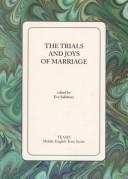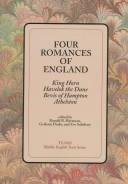| Listing 1 - 10 of 10 |
Sort by
|
Book
ISBN: 1137436379 1137436360 Year: 2017 Publisher: New York : Palgrave Macmillan US : Imprint: Palgrave Macmillan,
Abstract | Keywords | Export | Availability | Bookmark
 Loading...
Loading...Choose an application
- Reference Manager
- EndNote
- RefWorks (Direct export to RefWorks)
This book addresses portrayals of children in a wide array of Chaucerian works. Situated within a larger discourse on childhood, Ages of Man theories, and debates about the status of the child in the late fourteenth century, Chaucer’s literary children—from infant to adolescent—offer a means by which to hear the voices of youth not prominently treated in social history. The readings in this study urge our attention to literary children, encouraging us to think more thoroughly about the Chaucerian collection from their perspectives. Eve Salisbury argues that the child is neither missing in the late Middle Ages nor in Chaucer’s work, but is,rather, fundamental to the institutions of the time and central to the poet’s concerns.
Literature. --- Culture --- Literature --- Classical literature. --- Literature, Medieval. --- British literature. --- Medieval Literature. --- British and Irish Literature. --- Literary Theory. --- Cultural Theory. --- Classical and Antique Literature. --- Study and teaching. --- Philosophy. --- European literature --- Medieval literature --- Literature, Classical --- Literature and philosophy --- Philosophy and literature --- Cultural studies --- Belles-lettres --- Western literature (Western countries) --- World literature --- Theory --- Literature-Philosophy. --- Culture-Study and teaching. --- Literature, Ancient --- Greek literature --- Latin literature --- Literature—Philosophy. --- Culture—Study and teaching. --- Chaucer, Geoffrey, --- Criticism and interpretation. --- Characters --- Children. --- Chaucer, Jeffrey, --- Chʻiao-sou, Chieh-fu-lei, --- Chieh-fu-lei Chʻiao-sou, --- Choser, Dzheffri, --- Choser, Zheoffreĭ, --- Cosvr, Jvoffrvi, --- Tishūsar, Zhiyūfrī,

ISBN: 1580440355 Year: 2002 Publisher: Kalamazoo (Mich.) : Medieval Institute Publ.,
Abstract | Keywords | Export | Availability | Bookmark
 Loading...
Loading...Choose an application
- Reference Manager
- EndNote
- RefWorks (Direct export to RefWorks)
English literature --- Marriage --- 392.4/.5 "04/14" --- Middle English literature --- 392.4/.5 "04/14" Verloving. Huwelijk. Huwelijksgebruiken. Partnerkeuze. Polyandrie. Polygamie. Monogamie--Middeleeuwen --- Verloving. Huwelijk. Huwelijksgebruiken. Partnerkeuze. Polyandrie. Polygamie. Monogamie--Middeleeuwen
Digital
ISBN: 9781137436375 Year: 2017 Publisher: New York Palgrave Macmillan US :Imprint: Palgrave Macmillan
Abstract | Keywords | Export | Availability | Bookmark
 Loading...
Loading...Choose an application
- Reference Manager
- EndNote
- RefWorks (Direct export to RefWorks)
This book addresses portrayals of children in a wide array of Chaucerian works. Situated within a larger discourse on childhood, Ages of Man theories, and debates about the status of the child in the late fourteenth century, Chaucer’s literary children—from infant to adolescent—offer a means by which to hear the voices of youth not prominently treated in social history. The readings in this study urge our attention to literary children, encouraging us to think more thoroughly about the Chaucerian collection from their perspectives. Eve Salisbury argues that the child is neither missing in the late Middle Ages nor in Chaucer’s work, but is,rather, fundamental to the institutions of the time and central to the poet’s concerns.
Philosophy --- Philosophy and psychology of culture --- Sociology of culture --- Linguistics --- Old English literature --- English literature --- Literature --- Classical literature --- Klassieke literatuur --- geletterdheid --- cultuur --- filosofie --- literatuur --- culturele antropologie --- Engelse literatuur --- Chaucer, Geoffrey --- Great Britain --- Ireland
Book
ISBN: 9781879288621 Year: 2001 Publisher: Kalamazoo, Mich. : Consortium for the Teaching of the Middle Ages University of Rochester,
Abstract | Keywords | Export | Availability | Bookmark
 Loading...
Loading...Choose an application
- Reference Manager
- EndNote
- RefWorks (Direct export to RefWorks)
English poetry --- Knights and knighthood --- Romances, English. --- Poésie anglaise --- Romans courtois --- Celtic influences. --- French influences. --- Poetry. --- 1100-1500 (moyen anglais) --- Influence celtique --- Influence française --- Brittany (France) --- Histoire et critique --- Poésie anglaise --- Influence française

ISBN: 0813031273 9780813031279 9780813024424 0813024420 Year: 2002 Publisher: Gainesville : UPF,
Abstract | Keywords | Export | Availability | Bookmark
 Loading...
Loading...Choose an application
- Reference Manager
- EndNote
- RefWorks (Direct export to RefWorks)
''Challenges readers to acknowledge the extent to which violence figured in medieval texts and, with this recognition, to reconsider what the works teach us not only about the treatments and troping of victims in the medieval world but also how these patterns are a part of the social history of domestic violence.

ISBN: 1580440177 Year: 1999 Publisher: New York, NY : Western Michigan university,
Abstract | Keywords | Export | Availability | Bookmark
 Loading...
Loading...Choose an application
- Reference Manager
- EndNote
- RefWorks (Direct export to RefWorks)
Book
Year: 2002 Publisher: Gainesville (FL) : University Press of Florida,
Abstract | Keywords | Export | Availability | Bookmark
 Loading...
Loading...Choose an application
- Reference Manager
- EndNote
- RefWorks (Direct export to RefWorks)
Book

ISBN: 9781501514210 Year: 2022 Publisher: Kalamazoo, MI
Abstract | Keywords | Export | Availability | Bookmark
 Loading...
Loading...Choose an application
- Reference Manager
- EndNote
- RefWorks (Direct export to RefWorks)
Multi

ISBN: 9781501514210 9781501514234 9781501520563 Year: 2022 Publisher: Kalamazoo, Mich. Medieval Institute Publications
Abstract | Keywords | Export | Availability | Bookmark
 Loading...
Loading...Choose an application
- Reference Manager
- EndNote
- RefWorks (Direct export to RefWorks)
Multi

ISBN: 9781501516870 9781501516900 9781501527142 Year: 2024 Publisher: Kalamazoo, Mich. Medieval Institute Publications
Abstract | Keywords | Export | Availability | Bookmark
 Loading...
Loading...Choose an application
- Reference Manager
- EndNote
- RefWorks (Direct export to RefWorks)
| Listing 1 - 10 of 10 |
Sort by
|

 Search
Search Feedback
Feedback About UniCat
About UniCat  Help
Help News
News